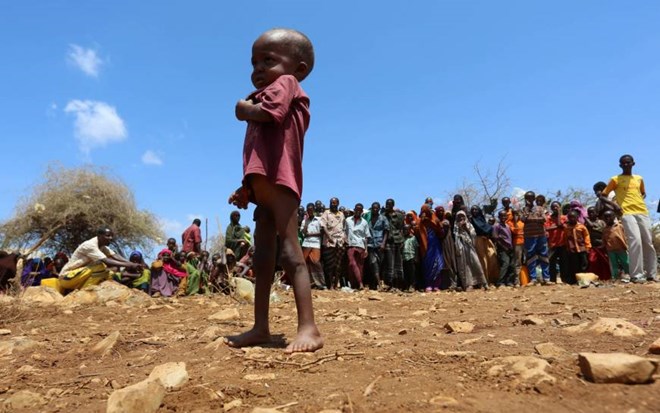
Monday March 27, 2017

An internally displaced Somali child stands among other people who have fled from drought-stricken regions at a makeshift camp in Baidoa, west of Mogadishu, Sunday. | REUTERS
An emaciated woman writhes on her hospital bed, weakly waving her bony hand to create a current of air.
Cholera patient Zeinab Hussein, a 50-year-old farmer, is one of thousands of desperate Somalis who have streamed into Baidoa in southwestern Somalia seeking food and medical care as a result the country’s prolonged drought. The influx has overwhelmed local and international aid agencies.
The hospital ward is filled with the sound of crying, malnourished children, many fed through tubes in their noses.
The new patients, mostly children, show signs of chronic malnourishment when they arrive at therapeutic clinics run by UNICEF, said aid workers.
The cholera epidemic is most prevalent among women and children. Cholera outbreaks often occur in refugee camps due to overcrowding and poor sanitation. Water scarcity also remains a major problem among the new arrivals in the refugee camps. In recent weeks, aid agencies have started a cholera vaccination campaign across Somalia.
Somalia’s drought is threatening 3 million lives, according to the U.N. In recent months, aid agencies have been scaling up their efforts but they say said more support is urgently needed to prevent the crisis from worsening.
More aid “is very important if we want to prevent the cholera from going out of control and also to prevent famine. We have to get the funding now to prevent it,” Steven Lauwerier, UNICEF’s representative for Somalia, said standing inside a Baidoa hospital ward.
“We are still ahead of the curve of the famine because now is when we can save lives,” he said. “This is not the time to have doubts that funding is not needed.”
Somalia’s emergency is joined by similar hunger crises in South Sudan, northeastern Nigeria and Yemen, which together make the world’s largest humanitarian disaster in more than 70 years, according to U.N. officials.
In Somalia, drought-stricken families have had to move from one place to another in order to reach international aid agencies that cannot distribute food in areas under the control of al-Shabab, Somali’s homegrown Islamic extremist rebels who are affiliated to al-Qaida.
With her newborn baby just 40 days old, Sangabo Madey walked for two days to reach a camp in Baidoa in search of food and water. Standing beside a hut of sticks and plastic sheeting, constantly blown by the wind, the mother of five said she does not know what to do next.
“We were unable to feed our children. Because of the drought we did not have anything to eat,” Madey said. “We left our hometowns to come here, but there is little aid coming in and we still continue to suffer.”